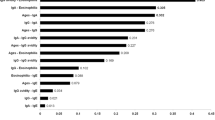Abstract
The ELISA test, using excretory-secretory antigen from larvae II of Toxocara canis, was applied on 1018 sera (793 from adults and 225 from pediatrics) distributed in: A) patients with an hypereosinophilia where the ethiological agent was undetermined (99); B) patients with ocular complaints compatible with an ocular toxocariasis (116); C) patients with hidatidosis (97); D) patient with other non-toxocaral helminthiasis (34); E) patients with other clinical features (468) and F) healthy donors (204).
Over 3,6 % of sera showed elevated levels of antibodies reacting with T. canis antigen. The prevalence of seropositivity was statistically higher in patients with eosinophilia (14,1%) (α < 0,001) and ocular complaints (6%) (0,025 > α > 0,01) than in the control group (1%). In the overall seropositivity from pediatrics did not differ from that of the adults.
Similar content being viewed by others
References
Anonimous (1980): Toxocariasis. JAMA 244: 17.
Ares M.E, Perez del Molino M.L., Villacorta M.I. and Fandiño M.T. (1987): Seroepidemiologia de la Toxocariasis humana mediante la tecnica de inmunofluorescencia indirecta. - A.P.E., V Congreso Nacional de Parasitologia, Salamanca, 233–234.
Borg D.A. and Woodruff W. (1973): Prevalence of infective ova of Toxocara species in public places. -Br. Med. J. 4: 470–472..
Tenoy Rodriguez S., Cuellar del Hoyo C. and Guillen Llera J.L. (1987): Estudio de posibles reacciones cruzadas del antigeno excretor-secretor de Toxocara canis frente a otros ascáridos y Proteina C-reactiva. -A.P.E., V Congreso Nacional de Parasitologia, Salamanca, 401–402.
Flentje B., Wittwer B. and Padelt H. (1983): Serologische Diagnostik der Larva migrans-Infektion beim Menschen. - Dtsch. Gesundheitswes. 38: 1059–1061.
Gallego J. (1982): Animales de compañia y antropozoonosis parasitarias en el medio urbano. -Pub. Real Academia de Farmacia, Barcelona.
Gallego J. and Pumarola A. (1952): El parasitismo por helmintos en los perros vagabundos de Barcelona. -Rev. lber. Parasitol. 12: 205–213.
Glickman L.T. and Schantz P.M. (1981): Epidemiology and pathogenesis of zoonotic Toxocariasis. -Epidemiol. Rev. 3: 230–250.
Guillen J.L., Fenoy S., Cuellar C. and Aguila C. (1987): Seroprevalence of anti-Toxocara antibodies in Spain.- III Mediterranean Conference on Parasitology, Jerusalem, 94.
Knapen F.van, Leusden J.van, Polderman A.M. and Franchimont J.H. (1983): Visceral larva migrans: examinations by means of enzyme-linked immunosorbent assay of human sera for antibodies to excretory-secretory antigens of the second-stage larvae of Toxocara canis. - Z. Parasitenk. 69: 113–118.
Maizels R.M., Savigny D.H.de and Ogilvie B.M. (1984): Characterization of surface and excretory-secretory antigens of Toxocara canis infective larvae.- Parasite Immunol. 6: 23–37.
Nicholas W.L., Stewart A.C. and Walker J.C. (1986): Toxocariasis: a serological survey of blood donors in the Australian Capital Territory together with observations on the risks of infection. - Trans. r. Soc. Trop. Med. Hyg. 80: 217–221.
Ree G.H., Voller A. and Rowland G.A.K. (1984): Toxocariasis in the British Isles 1982–3. - Br. Med. J. 288: 628–629.
Riera C., Muñoz C., Portús M. and Prats G. (1987): Puesta a punto de una técnica ELISA para la detección de anticuerpos anti-Toxocara. Ensayo en modelo experimental murino y su aplicación en el diagnóstico serológico de la “larva migrans” visceral humana. - Rev. Iber. Parasitol., Vol. Extra: 219–224.
Riera C. and Portús M. (1988): Diagnóstico de la Toxocariasis human mediante ELISA con antigeno secretor-excretor de larvas 11 de Toxocara canis. -Rev. Iber. Parasitol. 48: 95–100.
Savigny D.H.de (1975): In vitro maintenance of Toxocara canis larvae and a simple method for the production of Toxocara ES antigen for use in serodiagnostic tests for visceral larva migrans. - J. Parasitol. 61: 781–782.
Savigny D.H.de, Voller A. and Woodruff A.W. (1979): Toxocariasis: serological diagnosis by enzyme immunoassay. - J. Clin. Path. 32: 284–288.
Simon M.F. and Conde G.L. (1987): Datos epidemiologicos sobre la Toxocariosis y larva visceral emigrante en la provincia de Salamanca. - A.P.E., V Congreso Nacional de Parsitologia, Salamanca, 237–238.
Worley G., Green J.A., Frothingham T.E., Sturner R.A., Walls K.W., Pakalnis V.A. and Ellis G.S.Jr. (1984): Toxocara canis infection: clinical and epidemiological associations with seropositivity in kindergarten children. - J. Infect. Dis. 149: 591–597.
Author information
Authors and Affiliations
Rights and permissions
About this article
Cite this article
Portús, M., Riera, C. & Prats, G. A serological survey of toxocariasis in patients and healthy donors in Barcelona (Spain). Eur J Epidemiol 5, 224–227 (1989). https://doi.org/10.1007/BF00156835
Issue Date:
DOI: https://doi.org/10.1007/BF00156835




